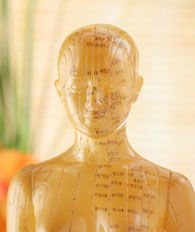New MRI research concludes that needling acupuncture points causes specific brain patterns associated with the treatment of specific diseases. Investigators compared two acupuncture points on the foot with a nearby sham acupuncture point. They discovered that the true acupuncture points consistently elicited specific brain responses in regions associated with their Traditional Chinese Medicine (TCM) medical indications and functions for therapeutic effects.
 Acupuncture ModelAcupuncture points LR3 (Taichong) and ST44 were compared with a sham point located between the two points. MRI scans revealed that LR3 uniformly stimulates specific regions of the cerebrum as does acupuncture point ST44. Although physically located in close proximity, each acupuncture point elicited its own, unique fMRI response in the brain. The researchers note that, “Acupuncture at adjacent acupoints elicits distinct cerebral activation patterns, and those specific patterns might be involved in the mechanism of the specific therapeutic effects of different acupoints.”
Acupuncture ModelAcupuncture points LR3 (Taichong) and ST44 were compared with a sham point located between the two points. MRI scans revealed that LR3 uniformly stimulates specific regions of the cerebrum as does acupuncture point ST44. Although physically located in close proximity, each acupuncture point elicited its own, unique fMRI response in the brain. The researchers note that, “Acupuncture at adjacent acupoints elicits distinct cerebral activation patterns, and those specific patterns might be involved in the mechanism of the specific therapeutic effects of different acupoints.”
The researchers noted that LR3 and ST44 stimulated distinct brain response patters and also shared some common areas of cerebral activation. Unique to LR3 was its stimulation of the middle occipital gyrus, an area related to the visual cortex. Acupuncture point LR3, although located on the foot, is traditionally indicated for the treatment of eye disorders within the Traditional Chinese Medicine system. The researchers note that this MRI finding is not isolated to this study. Other research also finds visual cortex activation elicited by needling foot acupuncture points that are specifically indicated for the treatment of eye disorders.
LR3 also activated the medial frontal gyrus, superior parietal lobe, thalamus and the limbic system. These areas are associated with the physiological processes of both pain and paralysis. LR3, according to TCM theory, is indicated for the treatment of pain and paralysis. The researchers note that, “The results confirmed the view that therapeutic
effects of acupuncture may work through the central nervous system pathway.”
The study notes that Traditional Chinese Medicine indications for acupuncture point ST44 are for the treatment of toothaches, sore throat, stomachache, swelling and pain of the foot. MRI imaging demonstrated that ST44 activated areas of the brain associated with pain processing: superior and inferior frontal gyrus, secondary somatosensory area. The researchers note that, “Our results provide supplementary neuroimaging evidence for the existence of acupoint specificity.”
This investigation concurs with another recent finding. Researchers concluded that acupuncture points CV12 and UB32 specifically stimulate the heart, stomach and intestines consistent with their TCM indications and functions. The study used electrogastrogram and HRV readings to verify the results. Another related MRI study of acupuncture points TB5 (Waiguan), GB34 (Yanglingquan) and GB20 (Fengchi) finds that these acupuncture points traditionally used for the treatment of migraines activate specific brain regions associated with pain reductions. PET-CT neuroimaging revealed that acupuncture “induce(s) different cerebral glucose metabolism changes in pain-related brain regions and reduce(s) intensity of pain” for patients with migraines.
A wealth of recent MRI research has measured acupuncture point specificity. University of California School of Medicine (Irvine) researchers analyzed MRI based acupuncture studies and concluded that, “Recent evidence shows that stimulation of different points on the body causes distinct responses in hemodynamic, fMRI and central neural electrophysiological responses.” The MRI findings demonstrated that “stimulation of different sets of acupoints leads to disease-specific neuronal responses, even when acupoints are located within the same spinal segment.” The culmination of this research helps us to gain greater understanding as to the mechanisms by which acupuncture exerts its effective actions.
References:
Liu, Hua, Jian-Yang Xu, Lin Li, Bao-Ci Shan, Bin-Bin Nie, and Jing-quan Xue. "fMRI Evidence of Acupoints Specificity in Two Adjacent Acupoints." Evidence-Based Complementary and Alternative Medicine 2013 (2013).
Minagawa, Munenori, Yasuzo Kurono, Tatsuyo Ishigami, Atsushi Yamada, Toshinori Kakamu, Ryoichi Akai, and Junichiro Hayano. "Site-specific organ-selective effect of epifascial acupuncture on cardiac and gastric autonomic functions." Autonomic Neuroscience (2013).
A PET-CT study on specificity of acupoints through acupuncture treatment on migraine patients. Jie Yang1, Fang Zeng1, Yue Feng1,Li Fang1, Wei Qin2, Xuguang Liu1, Wenzhong Song3, Hongjun Xie3 , Ji Chen1, Fanrong Liang1.
Point specificity in acupuncture. Chinese Medicine 2012, 7:4 doi:10.1186/1749-8546-7-4. Emma M Choi, Fang Jiang, John C Longhurst. Susan Samueli Center for Integrative Medicine, Department of Medicine, School of Medicine, University of California, Irvine CA.

